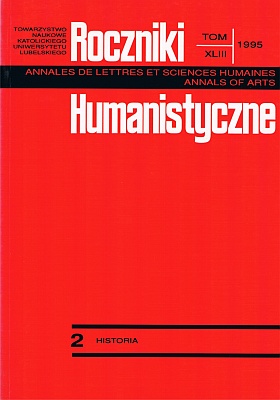Organizing the Parochial Network in the Wysocice Dekanate in the Middle Ages
Abstract
The present paper seeks to show how the parochial network was being organized in the Wysocice deaconate in the Middle Ages. We mean then to unfold the process of initiating and making dense the network of basic territorial units of the Church on the territory within the boundaries of the 14th-century Wysocice deaconate. The latter was situated in the Cracov dioceses, in the Cracov archdeaconate, and embraced the area of 1147 square km. It was set up in the neighborhood of Cracov, then the capital city. We may presume that the territories which it embraced were well-planned and relatively early peopled. This obviously had a bearing on the process of establishing parishes. They were setting up in this region as early as the most ancient period.
The paper has been divided into three chronological periods. The first one embraces the earliest period, until 1200. Due to the lack of sources from this period the dates of erecting some of the churches have been settled with a considerable approximation. This has been done by means of a research method which takes advantage of the conclusions drawn out of the later period (the so-called relics). This method is largely used in settling the dates of erecting churches in the second period, spanning the years 1201-1325, though in this case the direct sources may have been used to a greater extent. It is different in the third period concerning the period after 1325. In this case the method based on relics had only a subsidiary significance, whereas the principal role was played by the 14th-century sources.
Not all results at which we have arrived are accurate. They allow us, however, to state that until the end of the 12th century 12 parishes had been established in the Wysocice deaconate. This means that ca in 1200 one church embraced with its pastoral care people living on the area of 95.5 square km, while parishes in other regions of the Cracov dioceses were at that time twice, three, four or even over five times larger. This means that the founding action was very active in this earliest period.
Between 1201 and 1325 15 new parishes were established. This made, along with the earlier parishes, the number of 27 churches. That is why the average area of a parishes diminished to 42.5 square km at that time.
In the final period (after 1325) 13 parishes were established, one of which soon disappeared. Eventually then in the Wysocice deaconate 40 parishes were established in the Middle Ages, and the average size of a parochial district dwindled to 29 square km (29.5 square km after deducing the parish which disappeared). It is worth noting that both in the first and in the second period were established over two thirds of all parishes in this region. We may then say that the basic part of the parochial network of the Wysocice deaconate was established still before 1325. It is also worth emphasizing that half a century later (before 1386) the process of forming the medieval parochial network was finally stopped.
The density of parochial structures in the Wysocice deaconate varied in particular periods. As it seems its pace was slowest in the first stage, up to 1200. Then the process gathered momentum to reach its apex in the second quarter of the 14th century. Then it slowed down and before the end of the 14th century came to a halt.
In the beginning the parishes were founded first of all in the eastern part of the deaconate. Then also the central regions were occupied, and in the 14th century the western regions of the Wysocice deaconate.
To sum it up, one may state that the parochial network took shape in the Wysocice deaconate relatively early (before the end of the 14th century) and was, especially in the earliest period, extremely dense.
Copyright (c) 1995 Roczniki Humanistyczne

This work is licensed under a Creative Commons Attribution-NonCommercial-NoDerivatives 4.0 International License.





